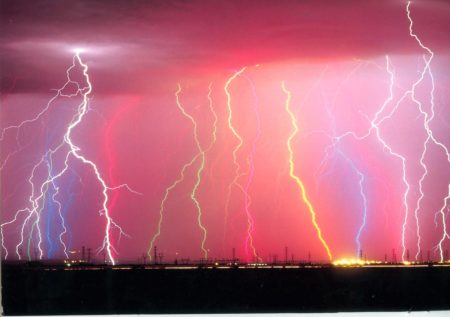February 14, 2020 – Happy Valentine’s Day. From sparks of love on this day to the sparks generated by static electricity, our topic for the day explores static sparks and the potential this energy source has to meet growing global electricity demands.
The scientific name for the static charge you receive when you walk across carpeting in a room and then touch a metal doorknob is triboelectricity. In dry interior conditions in Canadian winters, we all get “shocked” by these static charges. And some of you may remember public school science experiments when we rubbed a metal rod against silk or fur and touched an object to cause a spark.
Triboelectricity is electrical energy that occurs when two objects interact causing electrons from one to jump to the other. The amount of electric charge is usually quite small, yet measurable. But what if we could harvest the collective amount of energy produced from triboelectricity to help power devices, or even entire homes and towns?
James Chen is an Assistant Professor of Mechanical and Aerospace Engineering working at the School of Engineering and Applied Sciences at the University at Buffalo in New York. Chen, in an article published in 2019 states, “The friction between your fingers and your smartphone screen. The friction between your wrist and smartwatch. Even the friction between your shoe and the ground. These are great potential sources of energy that we can to tap into.”
Chen, along with Zayd Leseman, Associate Professor of Mechanical and Nuclear Engineering at Kansas State University in Manhattan, Kansas, is studying the triboelectric effect on nanomaterials. The goal is to build different types of triboelectric nanogenerators (TENGs) capable of controlling and harvesting static electricity and recently received a $400,000 USD National Science Foundation grant to pursue the research.
Chen and Leseman are not alone in studying the potential of harvesting triboelectricity. Zhong Lin Wang, of Georgia Tech, has built a triboelectric generator capable of powering an array of 1,000 LED lights just by tapping a foot. He has published a number of books on the triboelectric effect and in an article that appeared in Discover last fall, stated, “In our environment, everything is moving, everything is changing…It’s all energy, and so much is wasted.” Like his Buffalo and Kansas colleagues, Wang is convinced that triboelectricity can help solve the power needs of our civilization without the menace of greenhouse gas (GHG) emissions, and pollution. A demonstration device he invented is a ball containing a smaller one inside. When shaken it can light up an LED. The more the ball shakes, the brighter the light. There is nothing particularly exotic about the materials Wang is using to produce an electric current.
Studying triboelectricity is not a new science. In fact, it is one that appears to have been abandoned back in the 19th century when Michael Faraday invented the first electromagnetic generator, the foundation for the Industrial Revolution of the last two hundred years, and a contributing factor in our current global warming crisis.
Wang’s ball is a TENG relying on contact between two materials, the interior lining of the larger ball with the exterior surface of the smaller inside ball. The slightest bobble generates power. Wang estimates that 1,000 of these balls could power a standard lightbulb, and a grid 0.85 square kilometers (a third of a square mile), could power a small town.
On an entirely different triboelectricity scale, there is lightning. On the How Stuff Works website, it describes the potential energy that could occur if we were to capture just one lightning bolt strike, equivalent to 5 billion joules (almost 1,300 Kilowatts) or enough to power a typical North American home for up to a month.
With that much energy one would think this would be a great source of electrical power. But the challenges are many including logistics and infrastructure.
In terms of logistics, it is nearly impossible to predict when a lightning bolt will strike a specific place on the planet where the energy can be captured.
In terms of infrastructure, the immense heat that accompanies the static charge means the materials used would have to be resilient to the extreme.
Ideas to channel lightning have emerged from time to time. In 2008 a French team from the Applied Optics Laboratory at ENSTA ParisTech tried to use a strong laser to direct electrical activity within storm clouds. It didn’t create any lightning. Four years later this same group was successful in capturing laboratory-generated lightning using a laser. So, in theory, this laser idea might eventually work.feature
Other experiments have attempted to replicate Benjamin Franklin’s kite-flying episode, (the lightning didn’t hit his kite in reality) using large airborne kites tethered to power cables to attract lightning strikes. So far, no research group has claimed demonstrable success.
A Brazilian research group argues that lightning’s energy can be captured by preventing it from striking. They suggest that the atmospheric conditions in the humid tropics that potentially lead to lightning could become a way to harvest the energy before a strike occurs. Called hygroelectricity, it would involve capturing triboelectricity from the air by absorbing it from water vapour. The technology would take advantage of the ionizing effect of water droplets in collision freeing up and transferring electrons through the creation of small static electrical charges.
The Brazilian research may have potential. It certainly would be far easier to capture the energy from water molecules in collision, than from a nanosecond bolt of lightning. It would make storing the energy far easier because today there is no technology as of yet capable of capturing a 5 billion joule nanosecond static charge without becoming seriously damaged in a short period of time.









